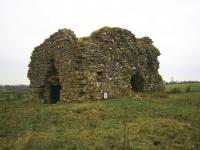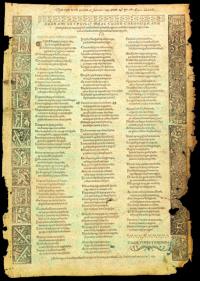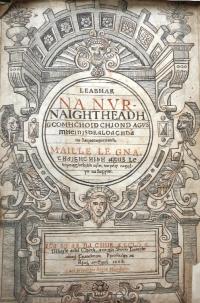‘Desirous to be delivered’:prophecy, printing and Puritanism beyond the Pale
Published in Early Modern History (1500–1700), Features, Issue 5 (Sept/Oct 2012), Volume 20
The ruins of Kilclooney Castle near Tuam, where Domhnaill Óg Ó hUigínn had run a bardic school since 1574. William Daniel praised Ó hUigínn’s contribution in the opening pages of Tiomna Nuadh (inset), his translation into Irish of the New Testament, saying that he had relied on him to proofread his work before printing. (Marsh’s Library)

Top of a 1571 broadsheet of a poem about Judgement Day by the fifteenth-century poet Pilip ‘Bocht’ Ó hUigínn trial-printed by Seaán Ó Cearnaigh (John Kearney), who was instrumental in overseeing the design and cutting of the original Gaelic type used for printing the first books in Irish. His nephew, William Kearney, printed the initial, incomplete, draft of Daniel’s New Testament in the early 1590s, having spent fourteen years abroad studying the ‘art and mystery of printing’. (Marsh’s Library)
‘Filthy frogs of the synagogue of Antichrist’
In 1596 William Daniel had been sent to Galway, and although the city had been described in the 1570s as ‘the paradise of Ireland in the number of professors of the Gospel’, this assessment changed as the Nine Years War progressed. The spread of the rebellion cut Galway off from central control, allowing Counter-Reformation clergy to return by sea unhindered. Daniel interpreted their arrival through the port as a biblical plague, denouncing them as ‘filthy frogs of the synagogue of Antichrist’ and ‘traitorous seminarists’. He attempted to convert the Galwegians by engaging in outdoor preaching but encountered opposition; while he had the support of the garrison, his house was still attacked and the windows broken. He was accompanied first to Galway and later to Tuam by Nicholas Walsh’s son, Abel, though his closest collaborator for much of his life was his predecessor in Tuam, Fearganainm Ó Domhnalláin (Nehemiah Donelan). The Donelans were a prominent family based near Headford in north Galway and are frequently mentioned in the Annals for their learning. Fearganainm answered to the name ‘Nehemias Daniel’ while he was at Catherine Hall, Cambridge, in the 1580s. On returning to Ireland he spent time in Kilkenny, where he met and then married William Daniel’s sister, Elizabeth. He was appointed archbishop of Tuam in 1595, on the recommendation of Thomas Butler, earl of Ormond, following the death of its first Protestant archbishop, William Lally. In the writ accompanying his appointment, Donelan was described as being ‘very fit to communicate with the people in their mother tongue . . . and that he had also taken great pains in translating and putting to the press the Communion-Book and New Testament in the Irish language, which her Majesty greatly approved of’.By 1595 a portion of the Irish New Testament had been printed, the rest of the books being initially attached in a handwritten form. To ensure accuracy in the translation before printing, Donelan and Daniel sought the help of the aforementioned Maoilín Óg MacBruaideadha, one of whose main patrons, Donnchadh Ó Briain, fourth earl of Thomond, was an enthusiastic Protestant, and from Domhnaill Óg Ó hUigínn, who since 1574 had run a bardic school at Kilclooney Castle near Tuam. Ó hUigínn also conformed, as, along with Archbishop William Lally, he was a signatory to the 1585 Composition of Connaught, overseen by the then lord deputy Sir John Perrot, which sought to extend the Elizabethan government’s hold over the west of Ireland. Daniel praised Ó hUigínn’s contribution in the opening pages of Tiomna Nuadh, saying that he had relied on him to proofread his work before printing.

Frontispiece of Leabhar na nUrnaithe gComhchoiteann
Native script used
The Ó hUigínns originally came from Leyney, Co. Sligo, thought to have been the birthplace of Seaán Ó Cearnaigh (John Kearney), who was instrumental in overseeing the design and cutting of the original Gaelic type used for printing the first books in Irish. The importance of the native script was noticed by an Englishman, John Denton, who, having spent time in Ireland in the 1560s, said of the native Irish that when it came to books being ‘prynted not in the Irishe caracter theye will not in anny wise well allowe of’. Kearney was at Cambridge with Nicholas Walsh in the 1560s and there he began to translate Protestant material. In 1571 he trial-printed a broadsheet containing a poem about Judgement Day by the fifteenth-century poet Pilip ‘Bocht’ Ó hUigínn, and in the same year 200 copies of his Aibidil Gaoidhheilge agus Caiticiosma were printed. Part Protestant catechism, part Irish primer, it was intended for use by Irish-speaking ministers until the prayerbook proper had been printed. Kearney’s familiarity with the work of the Ó hUigínns and his proposed appointment to the archbishopric of Tuam in 1572—which he declined—suggests that he too may have spent time at Kilclooney. His nephew, William Kearney, printed the initial, incomplete draft of Daniel’s New Testament in the early 1590s, having spent fourteen years abroad studying the ‘art and mystery of printing’.The printing of Tiomna Nuadh ar dTighearna agus ar Slanaightheora Iosa Criosd was completed by William Kearney’s English apprentice John Francton in Dublin in 1602. Three years later the government urged Daniel to print the Book of Common Prayer. He sought advice on the translation from the scion of another scribal family, Muircheartach Ó Cionga, the same ‘Mr Kyng’ who subsequently helped William Bedell—provost of Trinity College, who had attended Emmanuel College with Daniel in the 1580s—to translate the Old Testament into ‘plain Irish’ in the 1630s. Leabhar na nUrnaithe gComhchoiteann was printed by Francton in 1608. Daniel must have been present for much of the printing of the two books, with the typesetting stage of the process being subject to his oversight, as Francton, unlike Kearney, would not have had Irish. The depth of his involvement is reflected in a letter he wrote to Lord Deputy Arthur Chichester in 1609, in which he claimed that ‘having translated the Booke, I followed it to the Presse with ielousy, and daiely attendance, to see it perfected, payned as a woman in travell desirous to be delivered’. His translation was based largely on the 1604 edition of Thomas Cranmer’s Book of Common Prayer, though at this stage he also came into contact with a draft of what was to become the King James Bible, as a letter was sent in 1608 from another Emmanuel graduate, William Eyre, to James Ussher, requesting that Daniel return the draft in question to England. His translation of the prayerbook confirms him as a Puritan and it is evident from his outburst in Galway that he shared in the apocalypticism common amongst the early Protestants. The same millennarian tendency is noticeable in John Kearney’s choice of poem for his trial print.
Tuam made an ecclesiastical borough
In 1609 Donelan died in Tuam and Daniel was sent to replace him. Two years later he was given a seat on the Irish privy council. His promotions came with the recommendation of Chichester, who claimed that he was respected but also feared amongst his own people. He could act with zeal for his cause yet appears to have stood out for his relative moderation, as an early seventeenth-century Franciscan source, which recorded his arrest and imprisonment of a friar in Mullingar in 1617, referred to him not by name but as ‘Placidus [quiet, peaceful one], heretical bishop of Tuam’. He lived out the rest of his days in Tuam and his presence in the town undoubtedly contributed to the government’s decision to make it an ecclesiastical borough by royal charter in 1613. It had been 27 years since the last parliament had met and yet the Protestant population in Ireland remained so small that any new one would have automatically returned a Catholic majority. The authorities therefore contrived to ensure a Protestant majority by creating 40 new boroughs with two seats each. Tuam was included as it was the seat of an archbishop and ‘will send Protestants’.A sympathetic attitude towards him in subsequent Catholic sources suggests that something of a change came over Daniel in the last few years of his life. Why this is we do not know for sure, though the marginalisation of the Gaelic minority within Irish Protestantism in the aftermath of the ‘flight of the earls’ was a likely factor. A growing practical tolerance on his part is evident from as early as 1612. When ordered by Chichester to take the friary of Ross near Headford, he sent emissaries ahead, giving the friars time to remove themselves and their valuables to safer lodgings. He arrested, then released and later befriended Francis Kirwan, the Catholic vicar-general of Tuam, and when the Irish bishops made protest to King Charles I against the toleration of Catholic rights in 1626, Daniel was one of the few who refused to support them.
Native families divided
The situation in Tuam provides some insight into the way differing loyalties caused divisions within leading native families of the time. While one of Nehemiah and Elizabeth Donelan’s sons became a justice of the common pleas during the Cromwellian era, their youngest son, Muireachtach, parted ways with his brothers by becoming a Catholic priest. The Donelans’ daughter, Marian, married William Lally’s son, Isaac, who became Tuam’s inaugural ‘sovereign’ under the new borough system and the founder of a celebrated school in the town. Despite being obliged to take the Oath of Supremacy, Isaac Lally displayed an ambivalent attitude towards religious allegiance: not only was a future Catholic archbishop of Tuam, John de Burgo, tutored by him, but in the 1620s two Donegal natives on entering the Irish college in Salamanca named the school ‘close to Tuam’ as the place where they had been educated. William Daniel died in 1628 and was buried within St Mary’s Cathedral in Tuam. Ironically, his Tiomna Nuadh seems to have been much read initially by Catholics, as Geoffrey Keating, the seventeenth-century historian, was familiar with the 1602 edition. The Franciscans at Louvain also had early copies, as one of their leading lights, Hugh MacCaghwell, while he loudly denounced the prayerbook, made use of the New Testament and referred to Daniel himself as ‘duine mór onórach don nuachreideamh’. His translations were reprinted many times over subsequent years in both Ireland and Scotland and went through a significant revival during the ‘Second Reformation’ of the nineteenth century, when they were distributed in their thousands by the evangelical societies to Irish-speakers throughout the west of Ireland, ensuring that he remained a challenge to his Catholic counterparts in Tuam and elsewhere well over two centuries after his death. HI
Ruairí Ó hAodha works in Tuam Library, Co. Galway, and is the 2012 winner of the Irish Chiefs’ Prize in History.
Further reading
J. Lynch [1668], Pii Antistitis Icon or The life and death of Francis Kirwan, bishop of Killala (ed. C.P. Meehan) (Dublin, 1884).B. Ó Cuív (ed.), Aibidil Gaoidheilge & Caiticiosma: Seaán Ó Cearnaigh’s Irish Primer of Religion, published in 1571 (Dublin, 1994).N. Williams, I bprionta i leabhar: na Protastúin agus prós na Gaeilge, 1567–1724 (Baile Átha Cliath, 1986).
















